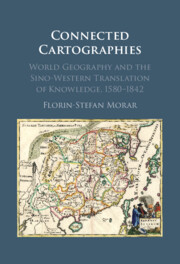Refine listing
Actions for selected content:
1295956 results in Books
Index
-
- Book:
- The Conquest of the Mountains
- Published online:
- 14 November 2025
- Print publication:
- 11 December 2025, pp 238-242
-
- Chapter
- Export citation
8 - The Translator
-
- Book:
- Fundamentals of Translation
- Published online:
- 04 December 2025
- Print publication:
- 11 December 2025, pp 245-279
-
- Chapter
- Export citation
Dedication
-
- Book:
- Representing Relationships
- Published online:
- 21 November 2025
- Print publication:
- 11 December 2025, pp v-v
-
- Chapter
- Export citation
Part III - Standards of Living
-
- Book:
- The Power of Peasant Consumers
- Published online:
- 27 November 2025
- Print publication:
- 11 December 2025, pp 211-294
-
- Chapter
- Export citation
Chapter 16 - Contemplations
- from Part IV - Concrete Operations of One-to-One Correspondence for Equality Matching, Arbitrary Symbolism for Market Pricing, Combinations of Conformations, and What Children Discover
-
- Book:
- Representing Relationships
- Published online:
- 21 November 2025
- Print publication:
- 11 December 2025, pp 348-364
-
- Chapter
- Export citation
Contents
-
- Book:
- American Performance in 1976
- Published online:
- 27 November 2025
- Print publication:
- 11 December 2025, pp vii-vii
-
- Chapter
- Export citation

Connected Cartographies
- World Geography and the Sino-Western Translation of Knowledge, 1580-1842
- Coming soon
-
- Expected online publication date:
- December 2025
- Print publication:
- 22 January 2026
-
- Book
- Export citation
5 - Sasun in the British Press
-
- Book:
- The Conquest of the Mountains
- Published online:
- 14 November 2025
- Print publication:
- 11 December 2025, pp 133-154
-
- Chapter
- Export citation
Preface
-
- Book:
- The Conquest of the Mountains
- Published online:
- 14 November 2025
- Print publication:
- 11 December 2025, pp ix-xi
-
- Chapter
- Export citation
Figures
-
- Book:
- Fundamentals of Translation
- Published online:
- 04 December 2025
- Print publication:
- 11 December 2025, pp xi-xiv
-
- Chapter
- Export citation
Bibliography
-
- Book:
- Protecting Women
- Published online:
- 27 November 2025
- Print publication:
- 11 December 2025, pp 303-326
-
- Chapter
- Export citation
39 - Performance Poetries
-
-
- Book:
- The Cambridge History of Australian Poetry
- Published online:
- 19 November 2025
- Print publication:
- 11 December 2025, pp 728-748
-
- Chapter
- Export citation
Chapter 4 - Neuropathology of Dementia
- from Section 1 - Introductory Chapters on Dementia
-
-
- Book:
- The Behavioral Neurology of Dementia
- Published online:
- 17 November 2025
- Print publication:
- 11 December 2025, pp 42-74
-
- Chapter
- Export citation
6 - Buying Benevolence
- from Part II - War in Mexico
-
- Book:
- Protecting Women
- Published online:
- 27 November 2025
- Print publication:
- 11 December 2025, pp 217-255
-
- Chapter
- Export citation
Chapter 15 - Cognitive Disorders of the Very Old: From Clinic to Pathology
- from Section 2 - The Dementias
-
-
- Book:
- The Behavioral Neurology of Dementia
- Published online:
- 17 November 2025
- Print publication:
- 11 December 2025, pp 239-249
-
- Chapter
- Export citation
Chapter 11 - Peasant Incomes
- from Part III - Standards of Living
-
- Book:
- The Power of Peasant Consumers
- Published online:
- 27 November 2025
- Print publication:
- 11 December 2025, pp 213-234
-
- Chapter
- Export citation
Chapter 5 - Shared Surfaces, Motion, and Fear
- from Part II - Consubstantial Assimilation: The Conformation System of Communal Sharing
-
- Book:
- Representing Relationships
- Published online:
- 21 November 2025
- Print publication:
- 11 December 2025, pp 116-146
-
- Chapter
- Export citation
Contents
-
- Book:
- Entanglements in World Politics
- Published online:
- 27 November 2025
- Print publication:
- 11 December 2025, pp vii-viii
-
- Chapter
-
- You have access
- Open access
- HTML
- Export citation
37 - Poetry of the South West Asian and North African Diasporas
-
-
- Book:
- The Cambridge History of Australian Poetry
- Published online:
- 19 November 2025
- Print publication:
- 11 December 2025, pp 692-711
-
- Chapter
- Export citation
4 - Rescuing the Enemy
- from Part II - War in Mexico
-
- Book:
- Protecting Women
- Published online:
- 27 November 2025
- Print publication:
- 11 December 2025, pp 147-182
-
- Chapter
- Export citation
